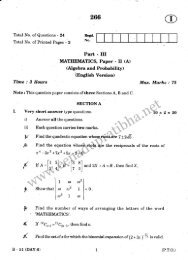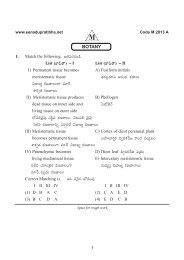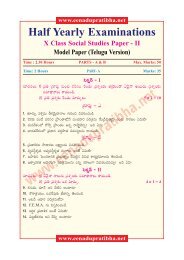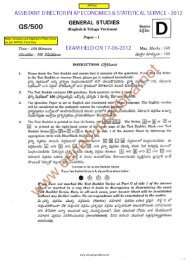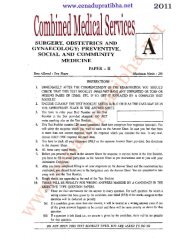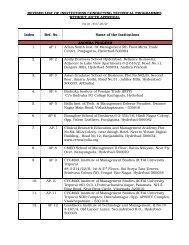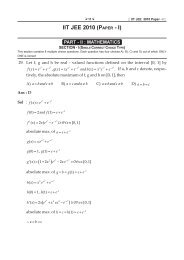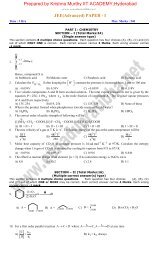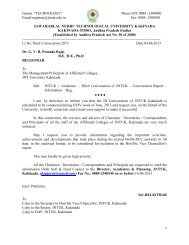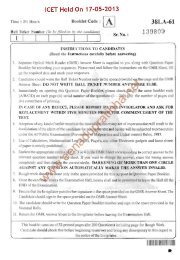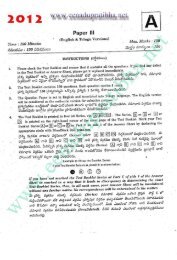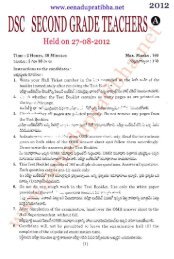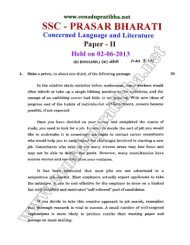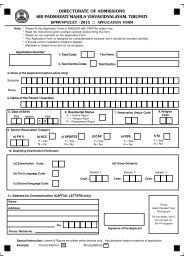b - eenadu pratibha
b - eenadu pratibha
b - eenadu pratibha
Create successful ePaper yourself
Turn your PDF publications into a flip-book with our unique Google optimized e-Paper software.
www.<strong>eenadu</strong><strong>pratibha</strong>.net<br />
S.S.C. Public Examinations<br />
Mathematics Paper - I<br />
Model Paper (English Version)<br />
Time: 2 1__<br />
2<br />
Hours PARTS A & B Max. Marks: 50<br />
Instructions: 1) Answer the questions under Part - A on a separate answer book.<br />
2) Write the answer to the questions under Part - B on the question<br />
paper itself and attach it to the answer book of Part - A.<br />
Time: 2 Hours PART- A Marks: 35<br />
SECTION - I<br />
Note: 1) Answer any FIVE questions, choosing atleast TWO from each of the<br />
following Groups A & B.<br />
2) Each question carries TWO marks. 5 × 2 = 10<br />
GROUP-A<br />
www.<strong>eenadu</strong><strong>pratibha</strong>.net<br />
(Statements and Sets, Functions, Polynomials Over Integers)<br />
1. Write the truth table of Disjunction.<br />
2. P, Q are the subsets of a universal set µ prove that P∩Q' = P − Q.<br />
f(x + h) − f(x)<br />
3. If f(x) = x 2 + 2x + 3 ∀ x ∈ R find ⎯⎯⎯⎯⎯⎯ where h ≠ 0.<br />
h<br />
4. Find the value of m so that x 4 − 2x 3 + 3x 2 − mx + 5 may be exactly divisible by<br />
x − 3.<br />
GROUP- B<br />
(Linear Programming, Real Numbers, Progressions)<br />
5. Indicate the polygonal region represented by the systems of inequations x ≥ 0,<br />
x ≤ 4, x ≥ y.<br />
6. Solve ⎢5 − x − 3<br />
⎢ ≤ 1.<br />
www.<strong>eenadu</strong><strong>pratibha</strong>.net<br />
√ ⎯ 1 + x − 1<br />
7. Evaluate x→0<br />
Lt ⎯⎯⎯<br />
x<br />
8. If 7 times the 7 th term of an A.P. is equal to 11 times the 11 th term. Show that the<br />
www.<strong>eenadu</strong><strong>pratibha</strong>.net
www.<strong>eenadu</strong><strong>pratibha</strong>.net<br />
18 th term of it is zero.<br />
SECTION - II<br />
Note: 1) Answer any FOUR of the following SIX questions.<br />
2) Each question carries ONE mark. 4 × 1 = 4<br />
9. Write the converse and contrapositive of the statement "If x is even then x 2 is<br />
even''.<br />
1 − x<br />
10. If f(x) = ⎯⎯ (x ≠−1) find f(0) and f(1).<br />
1 + x<br />
11. Expand ∑ a 2 (b 2 − c 2 ).<br />
12. Define Iso - profit lines.<br />
13. If (x 2/3 ) p = x 2 , find 'p'.<br />
t n−1<br />
14. If t 1 = 1, t n<br />
= ⎯⎯ (n ≥ 2) of a series. Find t 3 .<br />
n<br />
SECTION - III<br />
Note: 1) Answer any FOUR questions choosing atleast TWO from each of the<br />
www.<strong>eenadu</strong><strong>pratibha</strong>.net<br />
following Groups A & B.<br />
2) Each question carries FOUR marks. 4 × 4 = 16<br />
GROUP - A<br />
(Statements and Sets, Functions, Polynomials Over Integers)<br />
15. If A, B are two subsets of a Universal set µ then show that (A∪B)' = A' ∩ B'.<br />
16. Let f(x) = x − 1, g(x) = x 2 − 2, h(x) = x 3 − 3 for x ∈ R, find (i) (fog)oh,<br />
(ii) fo(goh).<br />
17. Let f be given by f(x) = x + 2 and f has the domain<br />
{x/2 ≤ x ≤ 5}. Find f −1 and its domain and range.<br />
18. Find the independent term of 'x' in the expansion of<br />
( 6x2 5<br />
) 8 − ⎯ .<br />
x 2<br />
www.<strong>eenadu</strong><strong>pratibha</strong>.net<br />
GROUP- B<br />
(Linear Programming, Real Numbers, Progressions)<br />
19. A manufacturer makes two models A and B of a product. Each model should be<br />
processed by two machines. To complete one unit of model A machines I and II<br />
www.<strong>eenadu</strong><strong>pratibha</strong>.net
www.<strong>eenadu</strong><strong>pratibha</strong>.net<br />
must work 1 hour and 2 hours respectively. To complete one unit of model B<br />
machines I and II must work 4 hrs and 2 hrs respectively. Machine I may not<br />
operate more than 8 hours per day, and machine II not more than 10 hours per day.<br />
If the profits on models A and B per unit are Rs.200 and Rs.280 respectively, how<br />
many units of each model should the manufacturer produce per day to maximise<br />
his profit<br />
1 1 1<br />
20. If lmn = 1 then show that ⎯⎯ + ⎯⎯ + ⎯⎯ = 1<br />
1+l + m −1 1+m+n −1 1+n+l −1<br />
21. The sum of 6 terms which form an A.P. is 345 the difference between the first and<br />
the last term is 55. Find the 6 terms.<br />
22. The A.M., G.M. and H.M. of two positive numbers are A, G, H respectively. Show<br />
that A ≥ G ≥ H.<br />
SECTION - IV<br />
(Polynomials Over Integers, Linear Programming)<br />
Note: 1) Answer ANY ONE question from the following.<br />
www.<strong>eenadu</strong><strong>pratibha</strong>.net<br />
2) The question carries FIVE marks. 1 × 5 = 5<br />
23. Using the graph of y = x 2 , solve x 2 − x − 2 = 0.<br />
24. Minimise f = 4x + 3y subject to x + y ≤ 8000, 2x + y ≤ 1000, 0 ≤ x ≤ 400,<br />
0 ≤ y ≤ 700.<br />
TIME: 30 MINUTES PART - B MARKS: 15<br />
Instructions: 1) Answer all the questions.<br />
2) Each question carries ⎯ 1 2<br />
mark.<br />
3) Marks will not be awarded for any over - written, re-written or erased answers.<br />
I. Write 'CAPITAL LETTER' of the correct answer in the brackets provided<br />
against each question.<br />
1. p Λ t ≡ p ( )<br />
A) Identity Law B) Idempotent Law<br />
C) Associative Law D) Complement Law<br />
www.<strong>eenadu</strong><strong>pratibha</strong>.net<br />
2. If A B then A − B = ( )<br />
⊃<br />
A) A B) B C) ∅ D) µ<br />
3. If f(x) = 1 − x, fog(x) = 2x ∀ x ∈ R then g(x) = ( )<br />
A) 2x B) 1 − 2x C) 1 − x D) 2x + 1<br />
www.<strong>eenadu</strong><strong>pratibha</strong>.net
www.<strong>eenadu</strong><strong>pratibha</strong>.net<br />
4. f = {(x, 2013)/ x ∈ N} is a ( )<br />
A) One - One function B) Bijective function<br />
C) Constant function D) Identity function<br />
5. y = mx 2 (m < 0) lies in the Quadrant ( )<br />
A) I, II B) II, III C) III, IV D) I, IV<br />
6. n C 0 + n C n = ( )<br />
A) 0 B) n C) 1 D) 2<br />
7. If x > 0, y < 0 then the point (x, y) lies in the Quadrant ( )<br />
A) I B) II C) III D) IV<br />
8. If 2 x+1 = 4 x−1 then x = ( )<br />
A) 2 B) 3 C) 4 D) 5<br />
9. If ∑n = 15 then ∑n 2 = ( )<br />
A) 225 B) 55 C) 215 D) 30<br />
10. The A.M. and G.M. of two numbers are 16 and 8 respectively. Then their harmonic<br />
mean is ( )<br />
A) 4 B) 8 C) 16 D) 32<br />
www.<strong>eenadu</strong><strong>pratibha</strong>.net<br />
II. Fill in the blanks<br />
11. If A B and B A then ........<br />
12. If (a + b, 1) = (5, a − b) then 2a + 3b is ........<br />
x + 1<br />
13. If f(x) = ⎯ ∀ x ∈ R − {1} then 3f(2) − 2f(3) = ........<br />
x − 1<br />
14. If the number of terms in the expansion of (x + y) n+1 is 5 then n = .......<br />
15. If a < 0, then the point (−a, −a) lies in ..... Quadrant.<br />
16. Equation of Y - axis is .....<br />
1 1 1<br />
17. Sum of the series 1 + ⎯ + ⎯ + ⎯ + ....... is .......<br />
3 3 2 3 3<br />
⊃ ⊃<br />
18. If k a , k b , k c are in G.P. then a, b, c are in ......<br />
19. The limiting position of secant of a circle is ......<br />
20. If x 1/2 = 0.1 = 0.1 then x 3/2 = ........<br />
III. Find the correct answers for the questions under Group - A, selecting them<br />
from Group - B.<br />
www.<strong>eenadu</strong><strong>pratibha</strong>.net<br />
www.<strong>eenadu</strong><strong>pratibha</strong>.net
www.<strong>eenadu</strong><strong>pratibha</strong>.net<br />
i) Group - A Group - B<br />
21. If n(A) = 15, n(B) = 20 ( ) A) F<br />
n(A∪B) = 30 then n(A∩B) =<br />
22. The truth value of ( ) B) −5/3<br />
If 2 × 5 = 10 then 2 − 5 = 3<br />
23. The zero of the function ( ) C) 5<br />
f(x) = 3x + 5 ∀ x ∈ R is<br />
24. The sum of the roots of the ( ) D) −3 √ ⎯ 3<br />
Quadratic equation<br />
√ ⎯ 3 x 2 + 9x + 6 √ ⎯ 3 = 0 is<br />
25. The discriminant of the quadratic ( ) E) −3/5<br />
equation px 2 + qx = r<br />
F) q 2 − 4pr<br />
G) T<br />
H) q 2 + 4pr<br />
ii) Group - A Group - B<br />
26. If P = 1 − 4<br />
x + 2 − 3<br />
y then the value ( ) I) x = k<br />
www.<strong>eenadu</strong><strong>pratibha</strong>.net<br />
of P at (0, 15)<br />
27. Solution set of the inequations x ≥ k, x ≤ k is ( ) J) −5/2<br />
3x − 5<br />
28. Lt ⎯⎯<br />
x→∞ 5x + 2<br />
( ) K) 1<br />
29. x a(b−c) . x b(c−a) . x c(a−b) = x r then r = ( ) L) 10<br />
30. If − − 2 , x, − − 7 are in G.P. then x = 7 2<br />
Solutions To Part - B<br />
( ) M) ±1<br />
N) 3/5<br />
O) 0<br />
P) −1<br />
I. 1-A; 2-C; 3-B; 4-C; 5-C; 6-D; 7-D; 8-B; 9-B; 10-A.<br />
II. 11) A = B 12) 12 13) 5 14) 3 15) First Quadrant 16) x = 0<br />
17) 3/2 18) A.P. 19) Tangent 20) 0.001<br />
III. i) 21-C; 22-A; 23-B; 24-D; 25-H.<br />
ii) 26-L; 27-I; 28-N; 29-O; 30-M<br />
www.<strong>eenadu</strong><strong>pratibha</strong>.net<br />
www.<strong>eenadu</strong><strong>pratibha</strong>.net<br />
REG - MP - 13



